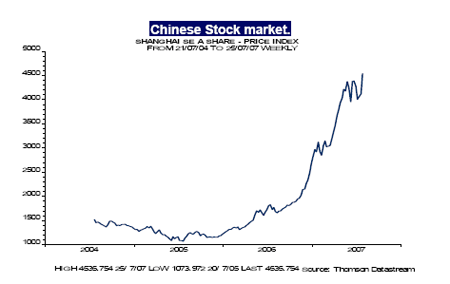
With sub-prime mortgage woes and concerns about credit and loan markets, there has been a flight to safety with 10-year US Treasury yields falling below 5%. But Asian equity markets and in particular, China are outperforming during this global equity correction. At the moment, the FTSE Asian Pacific ex Japan Index is up 28%, the FTSE Emerging Markets Index is also up 28% and Chinese equities are up 62% in the year to date.
This week Chinese equities actually bucked the global downtrend. China’s economy accelerated to a growth rate of 11.9% in the second quarter, the fastest rate of growth for 12 years. It appears that the new economies rather than the old economies are sustaining the world equity bull market, so far. Back home, the UK economy produced a valiant and above expected GDP growth of 3% in the second quarter and the FTSE 100 Index is unchanged on the year. As the old economies are being left behind in the wake of the fast growing new economies – it feels like the dot.com mania all over again.
China, since joining the World Trade Organisation in 2001, has produced a strong uplift in manufacturing output which has led to increased demand for oil and commodities, pushing many of these prices higher. In 2006, the Chinese economy grew by 11.1% to $2.8tr size and at this rate of growth it could soon overtake Germany. Certainly, it looks as if the breakneck growth is continuing. In the second quarter of 2007, economic growth accelerated to 11.9%. In addition, as household consumption is set to rise, helped by higher incomes and more access to consumer credit, when the Beijing Olympics opens in 2008, the economy could be in the grips of a consumer spending boom.
China’s trade surplus was $27bn in June and $229bn for the year to June 2007. Industry’s success has created vast foreign exchange reserves estimated at $1.3tr. Although the Yuan currency has risen to 7.56 to the dollar, the highest level since the end of the dollar peg in 2005, it is still regarded as being grossly undervalued. The Yuan really needs to appreciate much further otherwise there is a possibility of the economy overheating. The Chinese money supply is growing fast at +17% and inflation has risen to 4.4% in June. After the stronger than expected Q2 GDP numbers, the Peoples Bank of China raised its deposit and lending rate by 27 basis points, the fifth rise since last April.
Another danger is that these moves are not curtailing inflation because most of the upward inflationary pressure is coming from food. Interest rate increases could have more impact on investment and credit but fixed asset investment was up 27% in the first half of this year. One year lending rates are now 6.84% and with rising inflation more interest rate rises are on the cards. With US interest rates appearing to be on hold for some time, a stronger Chinese Yuan currency is to be expected but its 6% appreciation over the last two years has been too slow to stem howls of protest from US politicians.
With world risk aversion rising, one would expect a proper correction in Chinese equities. Yet, Chinese equities are finding new vigour despite its latest monetary tightening and a flight to quality. Despite the sell-off in global equity markets on Tuesday (S&P 500 Index -2%, FTSE 100 -1.9% and FTSE Eurofirst -1.4%) the Shanghai “A” market rose by 2.7% and on Thursday (another global sell-off) the Shanghai market rose by 0.5% to an all time high. There was a brief sell-off in February which caused international ripples but equities recovered quickly.
In May, the Government tried to cool down speculation on the stock market by tripling stamp duty on all share purchases. Although this temporarily slowed momentum it did not last long. China “A” shares are on a historical multiple of 46x and 32x for 2007 and 25x for 2008. Back in 2000, some TMT stocks were on multiples of 99x earnings. So, there is not far to go until we reach those dot.com multiples.
By Tony Shepard of the Global Economics and Strategy team at Charles Stanley